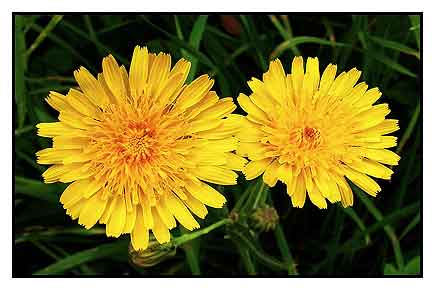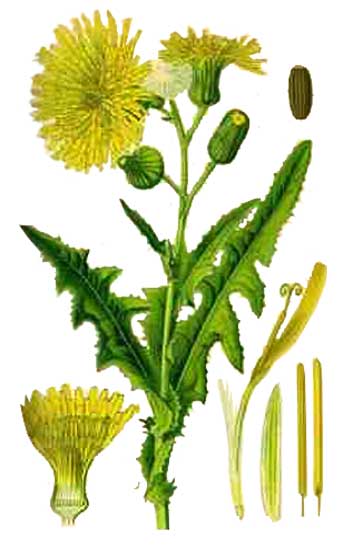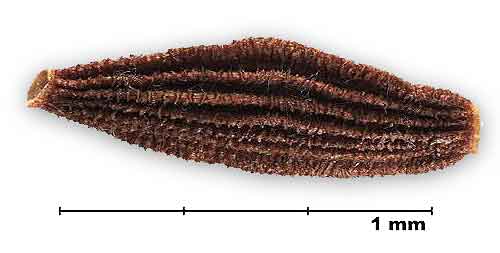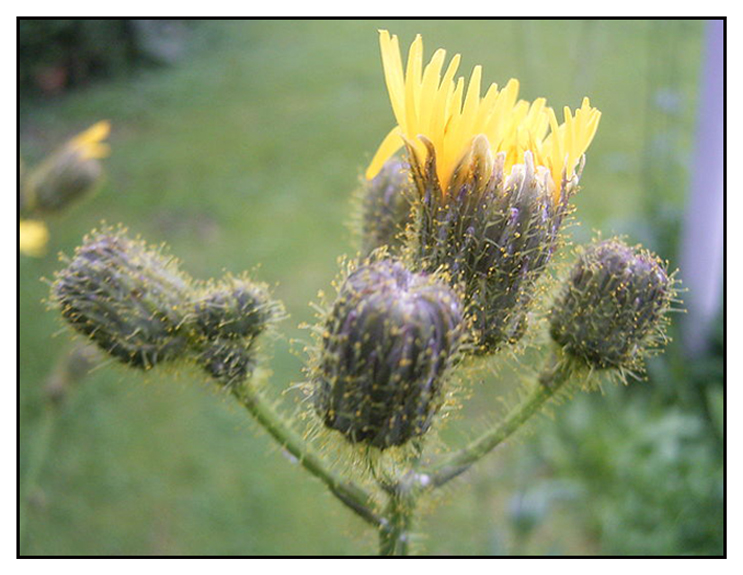 Gen info Gen info
- Sonchus is a genus of flowering plants in the dandelion tribe of the family Asteraceae and are commonly known as sow thistles. Sow thistles are annual, biennial or perennial herbs.
- It is a class of edible wild plant with50 known species wildly distributed in Europe, Asia, and Africa.
- Two varieties are common: var. arvensis and var. glabrescens, differing morphologically in the presence or absence of glandular hairs on peduncles and involucral bracts, respectively.
(21)
Botany
• Lamlampaka is an annual, milky herb, about 90 to 120 cm high, smooth towards the base, glandular and hairy upwards. Rootstocks are creeping. Leaves are pinnatifid, 10 to 18 centimeters long, with the lobes pointing downward; basal lobes rounded and appressed to the stem. Heads are yellow, 2.5 to 5 centimeters in diameter. Narrow achenes are somewhat compressed, with thick, regular ribs on each face.
 Distribution Distribution
- Introduced; invasive. (24)
-
Found only In Ifugao, Bontoc, Lepanto and Benguet Subprovinces in Luzon.
- In waste places, along trails, in old gardens and on talus slopes, at an altitude of 1,200 to 2,000 meters.
- Occurs in all warm countries.
Constituents
- Plant yields a fixed oil with stearic and palmitic acids; ceryl-alcohol, invert sugar, cholin and tartaric acid.
- Milky juice contains oxydase, coautchouc, mannite, l-inosite, a bitter principle, etc.
- Study isolated two flavone glycoside compounds - quercetin-3-O-alpha-L-rhamnoside and kaempferol-3,7-alpha-L-dirhamnoside.
- Study isolated twenty-six compounds, including quinic acid derivatives, a rarely naturally occurring (p-hydroxyphenylacetyl) quinic acids,and two new eudesmanolides.
- Phytochemical screening yielded kaempferol, quercetin, orientin, rutin, hyperoside, catechin, and myricetin. (See study below) (8)
- Study isolated eight compounds: palmitic acid (I), β-sitosterol (II), daucosterol (Ill), quercetin (IV), apigenin-7-O-β-glucopyranoside (V), luteolin-7-O-β-D-glucopyranoside (VI), quercetin-3-O-β-D-glucopyranoside (VII).
(14)
- Analysis of fatty acid composition of roots yielded eighteen fatty acids. The major fatty acids were myristic acid (26.23%), palmitic acid (26.23%), linoleic acid (19.94%), pentadecanoic acid (3.11%), stearic acid (1.49%) and behenic acid (1.27%).
(15)
- Study of whole plant yielded three quinic acid derivatives (1-3), the rarely occurring quinic acids, and two eudesmanolides (4-5), along with four known eudesmanolides (6-9). (16)
- In a study of methanol extract from Sonchus species, S. arvensis showed the highest total phenolic content (417.3 mg/g).
- Ethanol extract of leaves contained alkaloids, flavonoids, phenols, saponins, and tannins. (see study below) (28)
- GC-MS study of hydro-distilled essential oil from aerial parts yielded 35 compounds, representing 99.82% of total oil. Main components were n-octane (289.82%) and n--decane (11.09%). (see study below) (40)
 Properties Properties
- Bitter.
- Considered anti-inflammatory,
diuretic, lithotriptic, antiurolithiasis.
- Studies have suggested antibacterial, antiangiogenic, antiurolithiasis, antioxidant, phytoremediative, anti-gout, antihyperuricemic, anti-inflammatory, anti-plasmodial, hepatoprotective, nephroprotective, immunomodulatory, antidiabetic, non-teratogenic, anti-SARS-CoV
properties.
Parts used
Roots, leaves.
 Uses Uses
Edibility
- Young leaves are edible, raw or cooked; bitter. (20)
Folkloric
- Santals used the roots for jaundice.
- Plant used for chronic fevers, coughs, phthisis, bronchitis, asthma and pertusis.
- Decoction of roots used for asthma and cough. (20)
- Poultice of leaves used for anti-inflammatory activity.
(20)
- Fresh ground leaves applied directly on wounds or leaf juice applied as compresses to abscesses.
- Used for poisoning, swelling, and abscesses.
- Used in dissolving kidney stones.
- In the districts of Maharashtra, India, used for body pain, diarrhea, dysentery, fever, leucorrhea, leprosy, white spots of the skin, and ringworm. (3)
- Leaves and all parts have been used for treatment of urinary tract stones and gallstones, appendicitis, breast inflammation, dysentery, hemorrhoids, spermatorrhea, hypertension, deafness, rheumatism, gout, and bruises. (29)
Studies
• Antibacterial / Sesquiterpene Lactones: Study isolated two new sesquiterpene lactones together with 8 known compounds. Compounds 1 and 7 exhibited antibacterial activity against oral pathogen Streptococcus mutans ATCC 25175. (2)
• Triterpenes: Sow thistle is an excellent source of pentacyclic triterpenes, accounting for 6% of crude lipid extract or 0.2% of the dried plant. Gas chromatography of a triterpenoid fraction yielded α-amyrin (9%), β-amyrin (21%), lupeol (13%), taraxasterol (24%) and pseudo-taraxasterol (12%). (4)
• Phytochemicals / Antiangiogenic / Leaves: Study of leaves yielded secondary metabolites: lupeol, phytol, quercetin, and α-sitosterol. Preliminary studies showed a potential to prevent or cure angiogenesis related diseases. (5)
• Antiurolithiasis / Dissolution of Calcium Oxalate Stones: Study on tempuyung (Sonchus arvensis) leaves as tea showed time- and dose-dependent dissolution of calcium oxalate stones. (7)
• Flavonoids / Antioxidant Activity: Study evaluated various fractions for scavenging showed significant scavenging of free radicals (DPPH, ABTS, OH, superoxide), which may be attributed to polyphenolic constituents. The methanolic fractions showed to be more potent than other fractions. (See constituents above) (8)
• Synergistic Effects in Calcium Oxalate Bladder Stones: Study evaluated the anticalculi effect of Sonchus arvensis in bladder stone therapy. Results showed both preventive (inhibition of formation of bladder stone) and curative (inhibition of bladder stone enlargement and dissolving existing bladder stones) effects. (9)
• Prevention of CCl4-Induced Oxidative Stress: Study evaluated a methanol extract of S. arvensis against CCl4-induced adrenal oxidative stress in rats. Results showed S. arvensis efficiently prevented adrenal injuries induced by CCl4, possibly through antioxidant effects. (10)
• Phytoremediation / Phytochelatin Synthase / Lead: Study showed S. arvensis is a good candidate for Pb phytoremediation. The expression of PCS (phytochelatin synthase), the gene encoding enzyme that catalyzes phytochelatin biosynthesis was investigated. Results showed PCs content to be higher in shoots than in roots, and PC levels seemed related to Pb accumulation in shoots, and further suggests PCs might contribute to high Pb accumulation and tolerance in S. arvensis. (11)
• Toxicity Study / Leaves: Study evaluated the acute and subchronic oral toxicity of ethyl acetate extract of SA leaves in a Wistar rat model. Results showed no toxic effects and suggests the extract of leaves is safe after single administration at high dose and repeated administration for 90 days. The LD50 of the extract was higher than 15 g/kbw. (13)
• Synergistic Effect in Bladder Stone Therapy: Study of S. arvensis decoction showed two effects on bladder stone therapy: an inhibitory effect, decreasing by 47.47% the increment of bladder stone; and a curative effect, by 45.50% inhibition of increment and dissolving 4.02% of existing bladder stone. (17)
• Anti-Inflammatory / Inhibition of Locomotion and Gastrointestinal Motility / Aerial Parts: Study evaluated the pharmacological effects of methanolic extract of aerial parts. Results showed strong anti-inflammatory activity and inhibitory effect in gastrointestinal motility and locomotor activity in a dose-dependent manner. (22)
• Anti-hyperuricemia and Anti-Gout / Leaves: Study evaluated 12 plants use for treatment of gout in Indonesia. The ethanol extracts of S. rhombifolia stems and S. arvensis leaves showed highest inhibition of xanthine oxidase activity with IC50s of 21.43 µg/ml and 23.64 µg/ml, respectively. Results suggest the potential use of both plant extracts as alternative therapy of hyperuricemia and gout. (23)
• Antiplasmodial / Antioxidant / Cytotoxicity / Leaves: Study evaluated the cytotoxic effect, antioxidant, and antiplasmodial activities of S. arvensis leaf extracts both in vitro and in vivo. The n-hexane, ethyl acetate, and ethanolic extracts of S; arvensis leaves exhibited good invitro antiplasmodial activity with IC50s of 5.119, 2.916, and 8.026 µg/mL, respectively. The extracts showed high antioxidant activity with low cytotoxic effects. The ethyl acetate extract showed in vivo antiplasmodial activity with WD50 of 46.31 mg/kbw, as well has hepatoprotective, nephroprotective, and immunomodulatory activities in mice infected with P. berghei. (25)
• Antidiabetic / Leaves: Study evaluated the antidiabetic effect of ethanolic leaves extract of Sonchus arvensis and S. asper against alloxan-induced diabetic animals with doses of 100, 150, and 200 mg/kg. Results showed antidiabetic effect, The Sonchus arvensis leaf extract at high dose of 200 mg/kg was more effective than other concentrations after 14 days of treatment. (26)
• Effect on Blood Glucose and Plasma Insulin Levels / Leaves: Study evaluated the effect of S. arvensis leaf extract on STZ-induced diabetic mice's blood glucose and plasma insulin levels using doses of 50, 100, and 150 mg/kbw. Results showed the leaf extract could reduce postprandial blood glucose elevation and increased postprandial insulin levels at 60 minutes. The most effective dose is 50 mg/kbw. (27)
• Hypoglycemic / Nephroprotective / Leaves: Study evaluated the effect of ethanol extract of leaves on blood glucose levels and histopathology picture in white male rats induced with streptozotocin. The extract at dose of 300 mg/kbw was effective in reducing blood glucose levels with effect on the regeneration of renal tubular cells. (28)
• Antimalarial / Callus from Leaf Implants: Study evaluated the induction of callus from leaf implants of S. arvensis and its invitro antiplasmodial activity against 3D7 strain of Plasmodium falciparum. Combination of 1mg/L2,4-D and 0.5 mg/L BAP in dark incubation was the best treatment for callus induction of tempuyung, producing the best callus quality and shortest period of callusing. The methanol extract showed anti-plasmodial activity with IC50 of 0.343 µg/mL. (30)
• Irritant Sesquiterpene Lactone Glycosides: Study evaluated the irritant effects of sesquiterpene lactone glycosides isolated from S. arvensis (L.) ssp. arvensis. Seven compounds were identified viz. sonchuside-E, sonchuside-F, sonchuside-G, sonchuside-H, sonchuside-I sonchuside-A and pirciside C. The sesquiterpene lactones exhibited well-defined irritant responses compared with reference compound, euphorbium. Compound 1, sonchuside-E, was the most potent and persistent irritant with least ID whose reaction lasted more than 48 hours. Compounds 2 to 7 revealed medium intensity irritant reactions, and compound 7, pirciside C, the least irritant and least persistent. (31)
• Xanthine Oxidase Inhibitory of Quercetin / Leaves: Study evaluated the inhibiting effects of quercetin from S. arvensis leaf extract on xanthine oxidase, an essential enzyme for uric acid synthesis. Xanthine oxidase enzyme inhibitory activity in silico by molecular docking showed the quercetin has free energy binding -7.71 kcal/mol, more negative than allopurinol -5.63 kcal/mol. Results showed affinity of quercetin was stronger than allopurinol, which predicts greater potential in inhibiting xanthine oxidase enzyme activity, and potential for use as antihyperuricemic. (32)
• Anti-Gout Effect / Anti-Inflammatory: Study evaluated extract and fractions of S. arvensis for anti-inflammatory potential in monosodium urate-induced gouty arthritis in Wistar strain of rats (Rattus norvegicus). Results showed S. arvensis water fraction showed the most significant reduction in inflammatory cells compared to hexane and ethyl acetate fractions. The water fraction showed equal effect with positive control in reducing infiltration of inflammatory cells in the synovial tissue. The anti-gout effects were attributed to decreased inflammatory response in the synovial joint. (33)
• Antiangiogenic / Antioxidant / Leaves: Study evaluated the antiangiogenic and antioxidant properties of aqueous and methanol extracts of leaves. The extracts showed antioxidant activity. The aqueous extract exhibited higher DPPH radical scavenging and inhibition of xanthine oxidase than the methanol extracts. Antiangiogenic activity of the aqueous extract was also higher than the methanol extract. There was a correlation between antioxidant activity and antiangiogenic property, and potential for the plant for use in diseases related to angiogenesis such as cancer. (34)
• No Teratogenic Effect / Leaves: Study evaluated the safety data of tempuyung leaves (EETL) on pregnant Wistar rats using doses of 100, 400, and 1000 mg/kbw from day 6 to day 15 or pregnancy. Results showed no difference between EETL treated group with control group in parameters of fetal weight, organ weight, mortality rates, macroscopic fetal appearance, and skeletal condition. The EETL at test doses in rats did not show teratogenic effects. (35)
• Protective Against Gentamicin-Induced Tubular Necrosis / Leaves: Gentamicin is the most common nephrotoxic agent used for inducing ATN (acute tubular necrosis), which is marked by decrement of glomerular filtration rate causing waste metabolism retention (creatinine). Study evaluated the protective effect of Tempuyung ethanolic leaf extract on gentamicin-induced ATN. Simultaneous administration of EET with gentamicin ameliorated the nephrotoxic effects of gentamicin as evidence by significant improvement on histopathological changes and normalization of creatinine levels. (36)
• Effect of Dolomite on Antiplasmodial Activity / Callus: Study evaluated the effect of dolomite [CaMg(CO302] on growth (morphological structure and biomass), secondary metabolite production, and invitro antiplasmodial activity of S. arvensis callus. Results showed dolomite significantly affected callus growth, metabolite profile, and invitro antiplasmodial activity. GC-MS analysis detected four compounds from callus ethanolic extract; Pelargonic acid, decanoic acid, and hexadecanoic acid were major compounds. S. arvensis callus antiplasmodial activity showed IC50 of 5.037 µg/mL, three times lower than leaf methanolic extract and five times lower than leaf ethanolic extract. (37)
• Antihyperuricemia / Leaves: Xanthine oxidase is one of the enzymes that can inhibit uric acid synthesis. Study evaluated the effect of ethanol extract of tempuyung leaves on xanthine oxidase invitro. The ethanol extract of leaves showed IC50 of 23.37 ppm, higher than allopurinol at 17.16 ppm. which was used as reference. Results suggest potential of tempuyung leaves as antihyperuricemic. (38)
• Anti-SARS-CoV2 / Antiviral Via Targeting of Viral Protein / Leaves: Study evaluated an SARS-Cov-2 inhibitor from n-hexane fractions of leaves. α-Amyrin and ß-amyrin from n-hexane fraction of leaves showed activity as SARS-CoV-2 inhibitors through interactions on helicase, RdRp,
M pro, and RBD-Spike, both compounds showing more negative binding affinity than control drug and can produce stable chemical bond interactions in the ligand-protein complexes. The computational results need validation through an invivo and invitro research approach. (39)
• Essential Oil / Antibacterial / Aerial Parts: GC-MS study of hydro-distilled essential oil from aerial parts yielded 35 compounds, representing 99.82% of total oil. Main components were n-octane (289.82%) and n--decane (11.09%). MIC and MBC varied respectively between 12.5 to 100 and 100 to >400 mg/ml for all gram(+) and gram(-) bacteria. The bacterial strains included: Bacillus cereus, Staphylococcus aureus, Salmonella enterica, and Echerichia coli. Methanolic extract could also inhibit the growth of gram(+) and gram(-) bacteria. The inhibitory effect was more on gram(+) bacteria. (40)
• Amelioration of Colitis Via Adjustment of Gut Microbiota / Flavones: Study evaluated the protective effect of flavones from S. arvensis (SAF) on colitis induced by dextran sulfate sodium (DSS) in mice by regulation of gut microbiota (GM). Results showed SAF significantly attenuated body weight loss. DAI (disease activity index) was lower, colon length was significantly improved, and pathologic changes were ameliorated, and blood parameters were improved after SAF treatment. Study suggests the SAF protective effect against DSS-induced colitis in mice may have a connection with gut microbiota diversity. (41)
• Renoprotective Against Getamicin Toxicity / Combination of S. arvensis and A. cordifolia: Study evaluated the renoprotective effect of combination of Sonchus arvensis and Anredera cordifolia against gentamicin-induced nephrotoxicity in rats reduced the urinary N-acetyl beta-D-glucosaminidase (NAGase) specific marker. All treatment groups showed significantly decreased levels of creatinine and urea in serum and urinary NAGase. The combination of S. arvensis 25 mg/kbw and A. cordifolia 75 mg/kbw extract showed better nephroprotective effect in decreasing the NAGase as the early biomarker in kidney failure. (42)
• Antihypertensive /Angiotensin Converting Enzyme Inhibitory Activity / Leaves: ACE is an enzyme that converts Angiotensin I into Angiotensin II.
Angiotensin II has a strong vasoconstriction effect which induces hypertension. Study evaluated the angiotensin converting enzyme (ACE) inhibitory activity of ethanol extract of S. arvensis leaves. The extract showed ACE inhibitory activity at IC50 of 46.71 µg/ml, compared to reference drug captopril with IC50 1,26 µg/mL. Results suggest potential of S. arvensis as ACE inhibitor use for treatment of hypertension. (43)
Availability
Wild-crafted.
|

![]()



 Gen info
Gen info Distribution
Distribution Properties
Properties Uses
Uses 